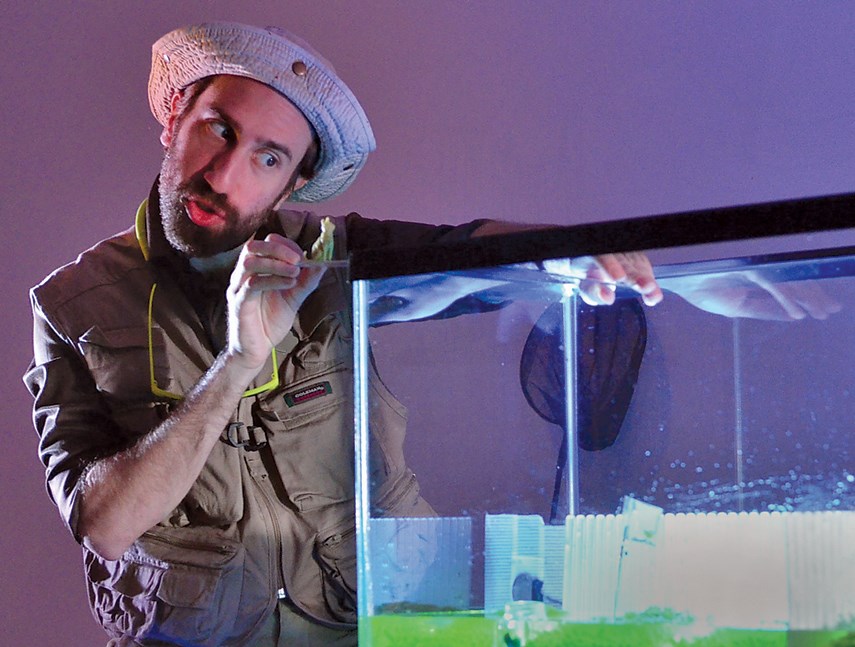Robert Leveroos performs High Water at the PuSh Festival, Feb. 1-5. Post-show talkback, Feb. 2 at 4 p.m. For showtimes visit .
The water rises, the lights illuminate, and the swimmer . . . doesn’t.
On the third floor of the Presentation House Theatre a trio of talented artists – each suddenly resembling Horseshoe Bay motorists told to expect delays – stop to consider the insubordination of their three-inch plastic toy.
“What do we think is wrong with the swimmer?” asks director and co-creator Elysse Cheadle.
The problem may not be with the swimmer itself, reasons composer and sound artist Nancy Tam.
Tam’s theory seems to be borne out when creator and star Robert Leveroos dips a plastic ruler into the fish tank stage. The water is 5.5 centimetres deep – a solid centimetre below the level that would lift the wind-up swimmer from his perch and send him into a powerful front crawl across the tank.
Leveroos appraises his collaborators.
“It may always be a bit of a surprise,” he admits.
He could be talking about the whole production. Ostensibly, High Water is a one-person show about sustainability. But, as he prepares to take the show to The Nest on Granville Island, Leveroos notes that defining the show is tricky. “[We] don’t want them coming in necessarily thinking they’re going to see a play-play,” he says.
An alumni of the Children’s Theatre Company in Minneapolis, Leveroos thinks of High Water as puppetry – only there are no strings and the rising water is a co-puppetmaster.
“It’s sort of its own strange form,” he says with a grin.
The premise is straightforward: the empty fish tank starts to fill with water. Grass, houses, vehicles flourish and then flood. All the while, Leveroos adapts to the rising sea level while speaking to the audience – sort of.
During rehearsal, Cheadle and Leveroos discuss just how articulate he can be with the director explaining the show’s three laws of communication.
“You have the vocabulary of making sound effects. You have the vocabulary of speaking to the objects. And you have the vocabulary of speaking as the objects,” she tells Leveroos.
For Leveroos, who has cultivated Harpo Marx-like facial expressions, that vocabulary is plenty.
After a damp rehearsal, Leveroos slips on dry socks and reflects on the two years of ideas and water hazards that went into the amphibious theatrical production.
There was an inherent appeal in staging a performance in an aquarium, Leveroos explains. It’s clear, easy to light, and as David Letterman proved, few games are as oddly suspenseful as Will It Float?
Asked if working with water is a logistical nightmare, Leveroos laughs.
“T´ÇłŮ˛ą±ô±ô˛â.”
The actor’s timing is only good if it accords with the rate of water flow. But Leveroos seems to appreciate the challenge, watching for the water to form a lip around a ball and tailoring his performance accordingly.
The show recently offered a sneak preview to first and second graders who launched into a debate about whether some white poofy props were marshmallows or snow.
For Leveroos, the argument was a sign the show was working. “Contradictions are kind of the point,” he says, explaining that it’s nice for theatre-goers to each have a unique experience based on their own perspective.
The show is presented with the Â鶹´«Ă˝Ół»International Children’s Festival, but ideally, Leveroos says, they’ll get kids and adults in the same room.
“It actually becomes richer when you get all of those people in one space,” he says. “Kids will take the experience seriously when they are sharing it with adults. . . . They’ll get a sense that we’re not playing down to them.”
As Tam and Cheadle tidy up and dry off the rehearsal space, Leveroos takes a moment to consider the pleasure of making theatre with your friends. “I love working with them. They make me laugh,” he says.
Through two years of rehearsals, ideas, changes, and questions of buoyancy, laughter has been a guiding force for the show, Leveroos explains.
“The things that make us laugh are the things that we want to keep.”


